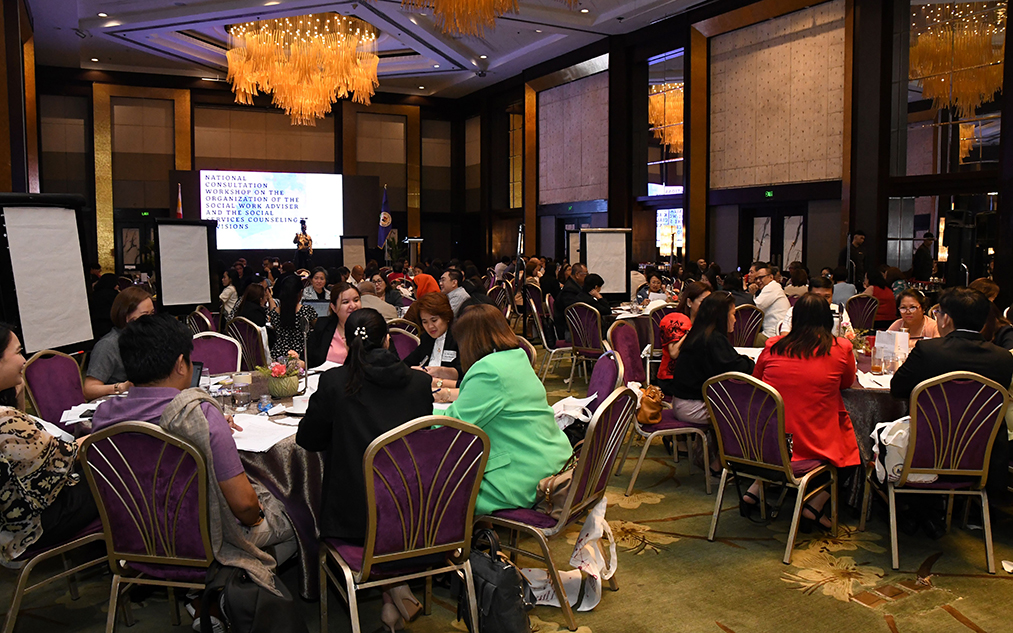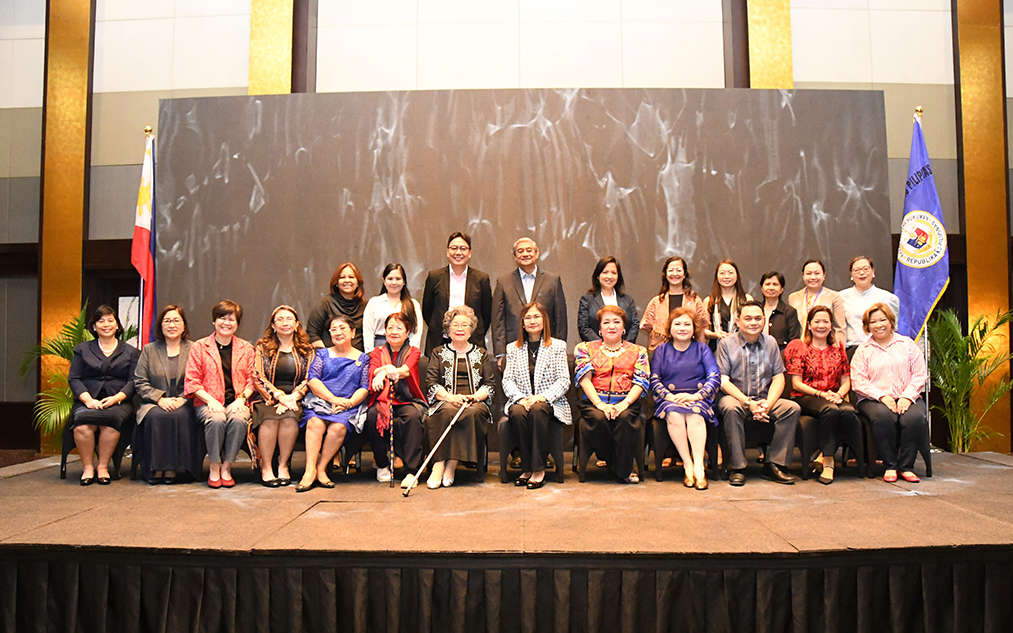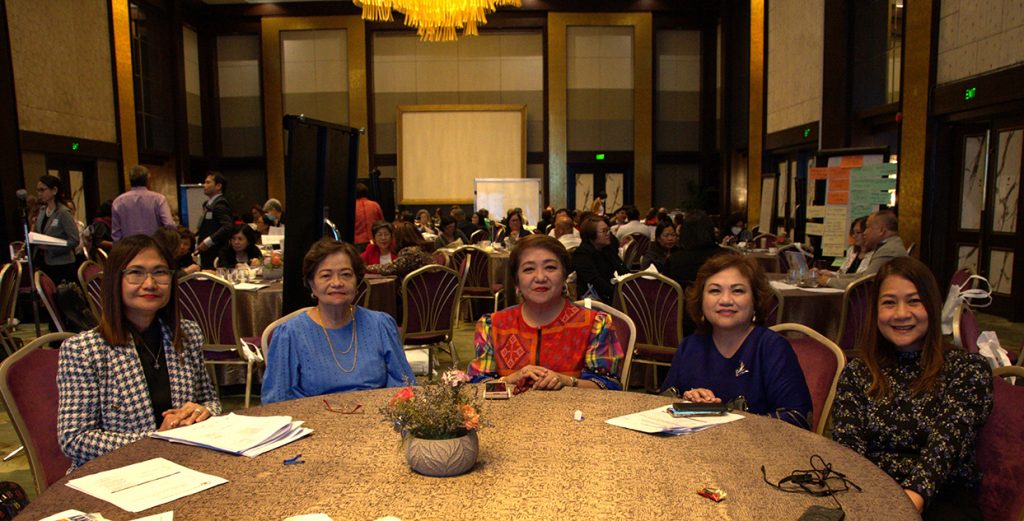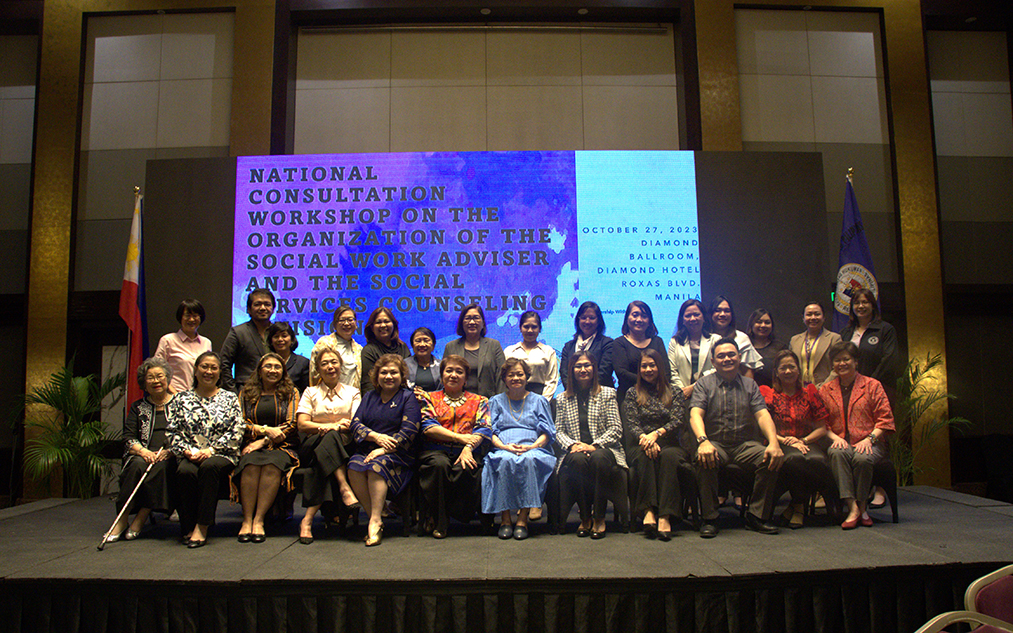SC Holds National Consultation Workshop for Establishment and Organization of SWA and SSCDs
October 27, 2023

Some 200 participants attended the National Consultation Workshop for the Establishment and Organization of the Social Work Adviser (SWA) and the Social Services Counselling Divisions (SSCDs) held at the Diamond Hotel, Roxas Boulevard, Manila on Friday, October 27, 2023. The workshop was organized by the Supreme Court, through its Committee on Family Courts and Juvenile Concerns (CFCJC). (Courtesy of the Supreme Court Public Information Office)
The Supreme Court, through its Committee on Family Courts and Juvenile Concerns (CFCJC), held the National Consultation Workshop for the Establishment and Organization of the Social Work Adviser (SWA) and the Social Services Counselling Divisions (SSCDs) at Diamond Hotel, Roxas Boulevard, Manila on Friday, October 27, 2023.
Chaired by Associate Justice Amy C. Lazaro-Javier, the CFCJC, through its Technical Working Group (TWG) gathered some 200 participants during the consultation workshop for the dissemination of the information on the pertinent provisions of the implementing rules and regulations (IRRs) of the Social Aspects of Republic Act No. 8369 or the Family Courts Act of 1997. The IRRs, among others, discuss the establishment of a Social Services Counselling Division in each judicial region, which shall be under the overall control and supervision of the SWA. The SSCDs shall provide appropriate social services to all family cases filed with the courts and recommend the proper social action.
Furthermore, the knowledge-sharing, which was facilitated by the CFCJC Technical Working Group (CFCJC TWG), also included a discussion on the organizational structure of the SWA and the SSCDs, and an exchange of inputs and feedback from various stakeholders, both from within and outside of the Judiciary.
The participants included judges handling family cases, court social workers, and other national government agencies in the justice sector and those that are directly involved in family cases filed in court. These include representatives from the Department of Justice, Department of Social Welfare and Development, Department of the Interior and Local Government, Department of Budget and Management, Civil Service Commission, and the Philippine Commission on Women, National Center for Mental Health, among others.
Sandiganbayan Associate Justice Maria Theresa V. Mendoza-Arcega discussed the IRRs on the Social Aspects of R.A. No. 8369, while Assistant Court Administrator Maria Regina Adoracion Filomena M. Ignacio discussed the organizational structure of the SWA and the SSCDs. Both are CFCJC TWG members.
CFCJC TWG member Deputy Court Administrator Jenny Lind R. Aldecoa-Delorino gave the Opening Remarks, while fellow CFCJC member Court of Appeals Associate Justice Jose Lorenzo R. Dela Rosa, along with The Asia Foundation Senior Legal Advisor Atty. Carolyn A. Mercado, gave the Closing Remarks.
Atty. Alberto T. Muyot, Save the Children Philippines Chief Executive Officer; UNICEF Philippines Child Protection Officer Atty. Marie Michelle D. Muňoz; and Australian Embassy in the Philippines Portfolio Manager Mr. Pablo Renato O. Lucero Jr. each gave a short statement and called for the prioritization of the best interest of children, as well as the protection of women and children.
An open forum was facilitated by Judge Maria Josefina G. San Juan-Torres, also a CFCJC TWG member.
In the afternoon, breakout sessions were conducted and the participants were divided into four clusters composed of three groups each. Each group was assigned to discuss among themselves one of the three sections of the SSCDs: (1) Social Services Section; (2) Statistics Section; and (3) Administrative Section. Thereafter, each cluster conducted a round-robin wherein each group commented on the discussion points of the other two groups. Thus, every cluster’s aggregated output comprises discussion points on the whole organizational structure of the SSCDs.
Under the IRRs, the Social Services Section shall cater to the social services needs of Family Courts and other trial courts handling family cases; the Statistics Section shall gather, maintain, analyze and prepare statistical and other relevant empirical data on child in conflict with the law (CICL) and Family Court cases and submit reports to the Office of the Court Administrator, through the SWA; while the Administrative Section shall receive documents, maintain an efficient filing of records, and facilitate the retrieval of records within the SSCD, as well as provide administrative support services to SSCD.
Also in attendance were other CFCJC TWG members: Court of Appeals Associate Justice Emily L. San Gaspar-Gito, Sandiganbayan Associate Justice Lorifel Lacap Pahimna, Deputy Clerk of Court and Judicial Reform Program Administrator Atty. Laura C.H. Del Rosario, Judge Flordeliz Cabanlit-Fargas, Judge Ester M. Veloso, Judge Jocelyn S. Dilig, and Judge Maria Josefina G. San Juan-Torres. Likewise, CFCJC consultants led by Chief Justice Teresita J. Leonardo-de Castro (Ret.), Judge Evelyn Jose Gamotin-Nery (Ret.), Judge Rosalina Luna-Pison (Ret.), and Prof. Myrna S. Feliciano. Chief Justice de Castro is former Chairperson of the CFCJC.
Deputy Court Administrator Leo T. Madrazo and Assistant Court Administrator Lilian C. Barribal-Co also joined the workshop.
The CFCJC conducted the national consultation workshop in partnership with the SaferKidsPH Consortium. An Australian Government initiative, SaferKidsPH is a consortium of Save the Children Philippines, The Asia Foundation, and UNICEF. ###

The Committee on Family Courts and Juvenile Concern (CFCJC) Technical Working Group (CFCJC TWG) members pose for posterity with the development partners and the CFCJC Secretariat. (Seated from left) Judge Flordeliz Cabanlit-Fargas, Judge Ester M. Veloso, Judge Jocelyn S. Dilig, Assistant Court Administrator Maria Regina Adoracion Filomena M. Ignacio, Judge Evelyn Jose Gamotin-Nery (Ret.), Prof. Myrna S. Feliciano, Ret. Judge Rosalina Luna-Pison (Ret.), Sandiganbayan Justice Lorifel Lacap Pahimna, Sandiganbayan Justice Maria Theresa V. Mendoza-Arcega, Deputy Court Administrator Jenny Lind R. Aldecoa-Delorino, Court of Appeals Justice Jose Lorenzo R. Dela Rosa, Judge Maria Josefina G. San Juan-Torres, and Deputy Clerk of Court and Judicial Reform Program Administrator Atty. Laura C.H. Del Rosario. (Courtesy of the Supreme Court Public Information Office)

Retired Supreme Court Chief Justice Teresita J. Leonardo-de Castro (second from left), former Chairperson and now consultant of the Committee on Family Courts and Juvenile Concerns (CFCJC), poses for posterity with CFCJC Technical Working Group members (from left) Sandiganbayan Justice Lorifel Lacap Pahimna, Sandiganbayan Justice Maria Theresa V. Mendoza-Arcega, Deputy Court Administrator Jenny Lind R. Aldecoa-Delorino, and Court of Appeals Associate Justice Emily L. San Gaspar-Gito. (Courtesy of the Supreme Court Public Information Office)

The members and consultants of the Supreme Court Committee on Family Courts and Juvenile Concerns (CFCJC) Technical Working Group, as well as the Secretariat, pose for posterity at the conclusion of the National Consultation Workshop for the Establishment and Organization of the Social Work Adviser (SWA) and the Social Services Counselling Divisions (SSCDs) held at Diamond Hotel, Roxas Boulevard, Manila on Friday, October 27, 2023. The workshop was organized by the Supreme Court, through the CFCJC. (Courtesy of the Supreme Court Public Information Office)












